04 January 2023
Different types of sales organization structure
Seven examples of sales organization structure
The sales organization structure supports the selling model. There are many different selling models depending on market structure, demand creation method, how the customer expects to purchase, distribution method, product category, and average transaction size.
Over the last 25 years the big disruption to the sales team structure has been the internet which has enabled buyers to both better research purchase options and, in an increasing number of cases, to start and/or complete the purchase process.
However, this impact has been greatest in consumer products (B2C). In B2B markets the average sales transaction values are much larger and more consideration is put into making purchase decisions. The need for people who perform sales functions is still present.
In B2B selling, the internet plays an important role in both demand creation (particularly SEO) and lead nurturing. Digital marketing is often the primary source of new customer enquiry (sales leads). The sales leads are fed in to a CRM and the sales team qualify the enquiries.
How to structure a sales department
Organizations develop the structure that best suits their business and market. Although it needs to be said that many organizations have legacy structures that haven't been challenged in many years "we've always done it this way."
With fast moving market conditions, consider the possibility there could be a better structure.
The aim is to optimize the sales organization structure to deliver the highest sales productivity with the least cost.
Human resource (people) is usually the highest cost of selling particularly in B2B sales. Optimization is driven by...
- Maximizing time spent on tasks that contribute to a sales outcome and minimizing time on tasks that (at best) could be described as administrative. Sales people designing half-arsed flyers in Power Point is my pet hate.
- The sales department is structured to support "having the right people, in the right place, at the right time."
- Taking low-value tasks away from high-value people (why have your top presenter/relationship builder spending a morning prettying-up a proposal when someone being paid half the salary could do it better and twice as fast?)
- Automating repetitive tasks both to increase efficiency and to drive consistency
- Installing efficient information systems.
Underpinning the above list is having identified the tasks that contribute to achieving sales. Such tasks might be (a few examples) proposal writing, face-to-face visits with potential and current customers, developing sales strategy (for each single sales opportunity), design and development, customer service, enquiry handling, etc. the list is long.
Having identified these tasks and working out how much time is typically allocated to each will then enable identifying the skill sets needed. It's the sales organization structure that then decides what tasks are allocated to each member of the sales team.

See how to structure a sales department for a more detailed explanation.
Here we present and discuss seven examples of sales organization structure and discuss each one. This list is by no means exhaustive, however we venture to suggest that all sales team structures are a variant on at least one of these and/or are hybrids of each example.
1. Lone Wolves sales structure
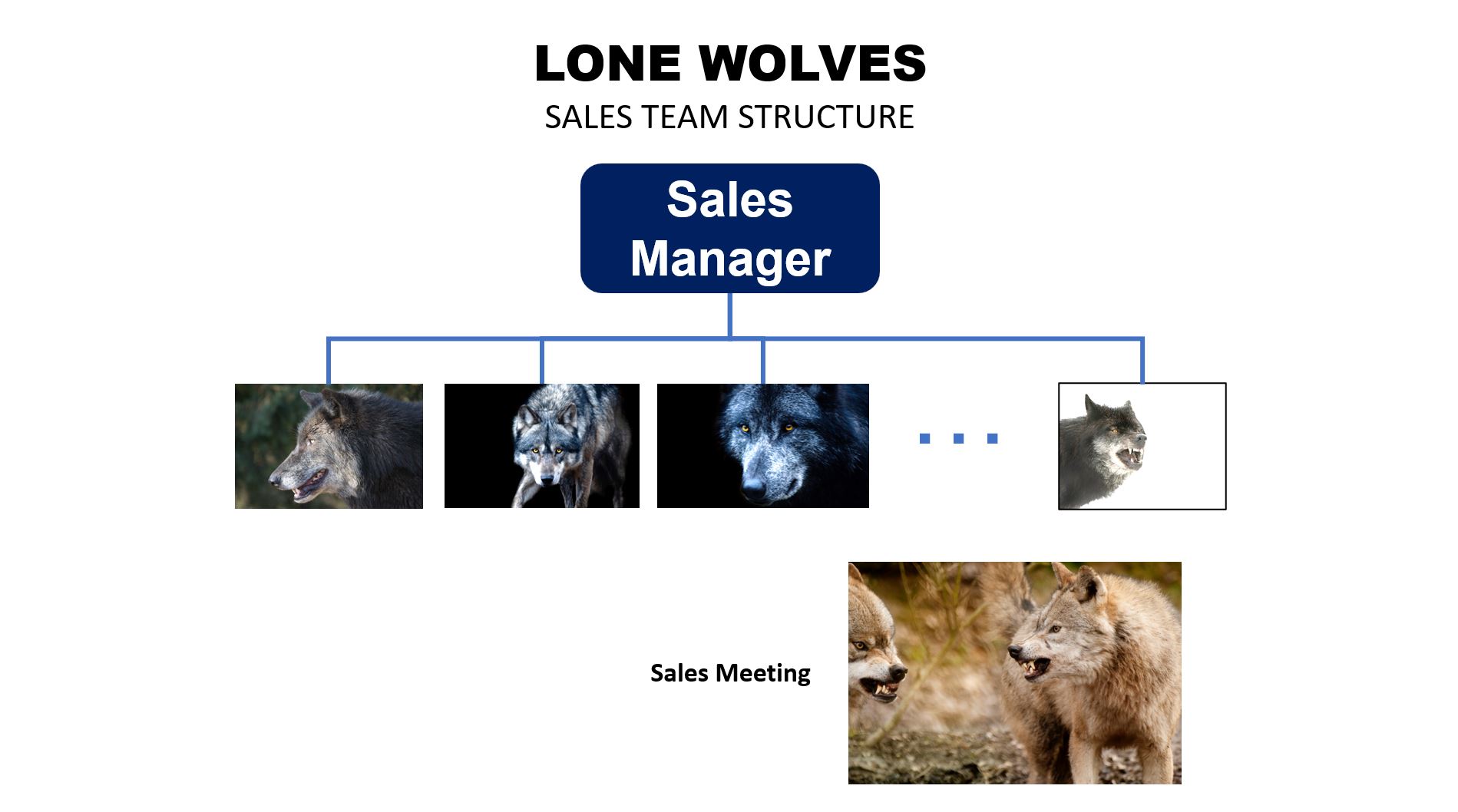
The simplest sales team structure is a collection of lone wolves.
Typically, remuneration is a low base combined with a high commission component. "Don't sell, you don't eat."
Each salesperson has free range on any sales opportunity without being allocated any type of territory. This often leads to conflict as two sales reps may find they are chasing the same opportunity. Although often there is a lead register system that allows each rep to claim a sales opportunity which they then have exclusive right to pursue and (depending on the selling model) may then become their customer. Provided everyone follows the rules.
However, if the sales manager detects that a representative is neglecting a particular customer they may allocate the customer to another rep.
In a lone wolf sales department structure, often sales are attributed (for commission purposes) to the sales person's name on the order when it is written-up. If a customer rings-in to order and their allocated rep is out of the office or otherwise not available, another representative may take the order thus stealing the sale. This inevitably leads to some robust conversations but the transgressor will argue "we were going to lose the order if I didn't write it up."
In some selling models lone wolves are fed inbound leads at the sales manager's discretion, on a round-robin basis (evenly) or simply by whoever happens to be in the office at that time. Sometimes the sales manager uses the allocation of sales leads as a means to maintain control. Jungle law.
The lone wolf sales team structure creates internal competition so that customers are keenly serviced and new opportunities pursued with vigor.
In mature lone wolf sales departments, the longer term sales representatives develop allegiances, pecking orders, and various informal agreements to minimize treading on each other's toes. This can make it difficult for new-comers to break-in and often find they are on the receiving end of treachery and "new-kid" tricks.
"Survival of the fittest" ensures the development of a sales team suited to the lone wolf environment (thick skinned, aggressive personalities who thrive on competition and high-drama).
Of course, there is another way of creating a more caring and sharing lone-wolves sales department. Pay everyone a high base, low or no commission salary structure and then the whole thing will settle down. You won't hear a peep, they'll all be curled-up in the corner asleep.
Advantages:
- It is not inevitable that the lone wolf sales organization structure results in conflict. The structure can settle into a less volatile environment if suitable rules are in place and enforced by a strong sales manager. However, keeping the team "mean and keen" is the purpose of the lone wolf sales structure.
- The lone wolf structure is suited to high performance teams where the sales transaction is relatively simple.
- Encourages sales representatives to think for themselves and self organize - "sink or swim."
- Built-in natural selection. Poor performers leave or face starvation.
- Less training cost: The rules needed to survive in this jungle and product knowledge are learned the hard-way. The smarter people learn on the run and adapt, the less so perish and leave.
Disadvantages:
- Potential for brand damage; often customer needs are subordinate to the needs of the sales team (customers are exposed to internal conflicts).
- You need a sales manager with very particular skill sets and a thick skin (more like a Drill Sargent) - these can be hard to find
- Complete lack of team work and even sharing of knowledge
- High turnover of sales representatives
- Potential for high levels of interpersonal conflict (and potential harassment, bullying, and unfair dismissal claims)
- Teams that have stabilized can be easily disrupted by changes to market conditions or personnel changes
- Requires high sales commission rates to attract and retain top-performers
- Not suited to many products/services particularly longer lead time and/or complex sales
- Sales representatives tend to treat their customers as their own and encourage direct contact by denigrating other sales team members or even the organization itself ("make sure you only talk to me, I am the only one who knows what's going on around here"). They will engage in secretive behavior for example not entering any contact records in a CRM and processing sales orders using the customer's accounts payable person as the key contact.
Typical industry applications:
- Simple transaction products and services. Quotes are quick to prepare if needed at all. Writing-up a sale is also quick.
- Motor vehicle sales. Retail environments. Financial products (particularly insurance).
2. Territorial sales structure
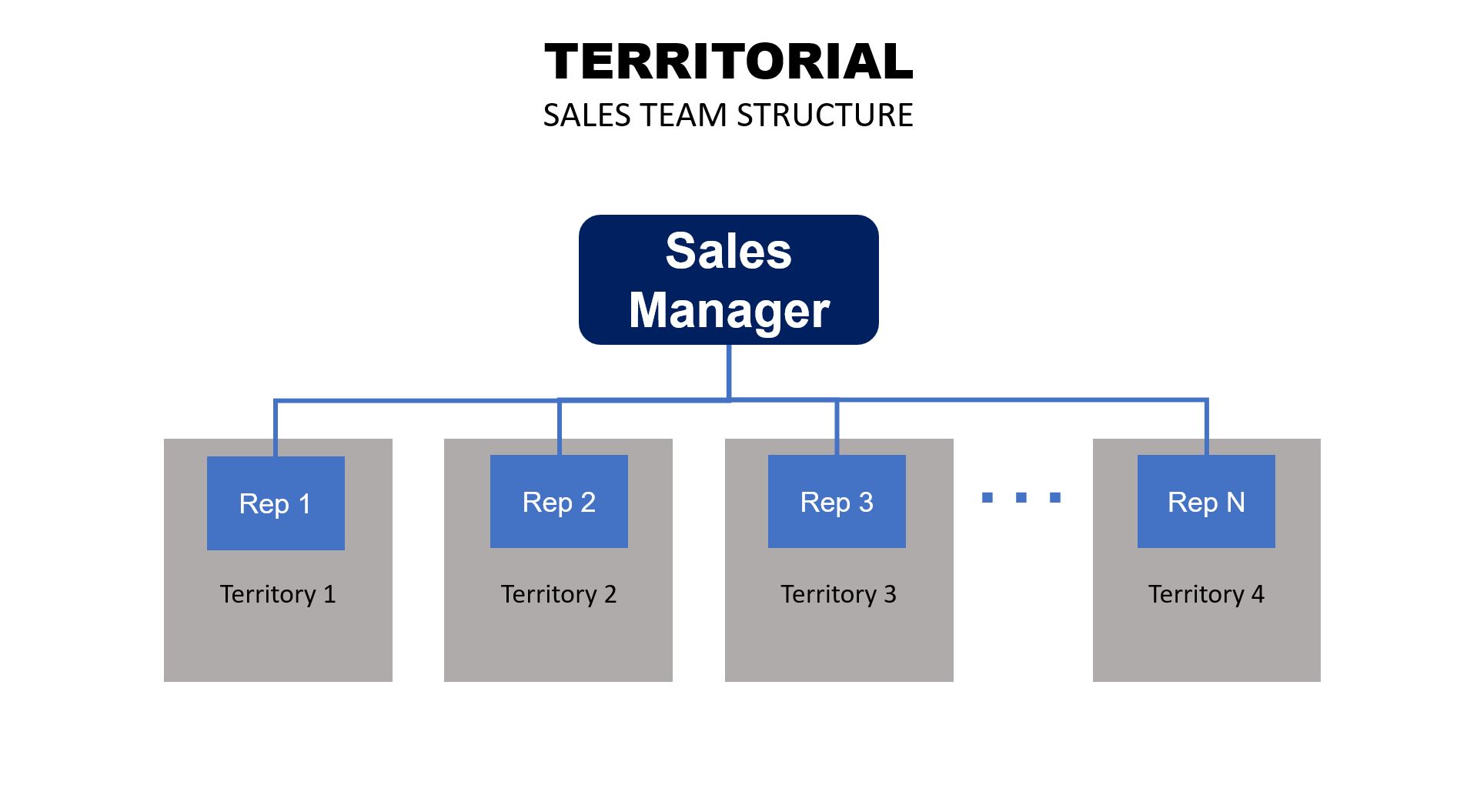
Sales territories can be segmented (spilt) geographically, by industry, by product group, by customer type, by sales channel or by any means that effectively creates a group of clients that are exclusively serviced by a sales representative. In sales department vernacular territories are called "patches".
Allocating sales representatives to a dedicated patch is a highly popular sales organization structure.
-
Territories segmented by industry: Domain knowledge can be important in sales. Understanding an industry (for example health, mining, oil & gas, tech, finance etc.) enhances sales effectiveness because the customer treats you as credible, you can envisage the problems your product/solution solves, can speak their language and can avoid mistakes that might arise by not understanding their industry.
-
Territories segmented by product group: similar to industry specialization, product specialization is needed when, to effectively sell the product, a large amount of product knowledge is required. This is often the case with technical products and services.
-
Territories segmented by customer size: It is is common to assign junior sales reps to smaller customers while they are learning and as they gain experience they can be trusted with the larger customers. However, it is also true that the style of selling for larger accounts can be different, more akin to account management than servicing the less frequent transactions of smaller customers.
-
Territories segmented by sales channel: Many organizations operate an omni-channel distribution strategy. A typical example is an automotive products distributor than sells their product online (operating a full e-commerce website), via 4WD shops, and through auto-parts distributors. Online sales are supported by an internal sales team providing telephone support, and account managers are appointed for each of the retail distributors. A possible 4th channel might include export - requiring a completely different type of sales specialist.
-
Geographic territories: dividing-up customers by geographic territory is a logical (and common) means of structuring a sales organization.
-
Hybrid territory segmentation: A hybrid sales organization structure combines (say) both geographic sales territories, with major accounts, and channel account managers. Or some variation depending on the selling model.
Allocating sales territories almost eliminates turf warfare between sales representatives but not always; there will always be customers that sit on the fence between one territory and another. For example, there will always be customers that operate in multiple territories, or in multiple industries, buy more than one product group etc. The sales manager is the umpire who resolves these disputes.
A common problem with geographic sales territories is when a customer makes the buying decisions in one geographic location but the product or service is delivered into another sales territory. Which sales representative is responsible for servicing the account? Which sales representative is credited with the sale when the order is written-up and/or the invoice is issued? For example, a mining company may have its head office located on St Georges Terrace in Perth but is making a purchase decision for a mine site located in Mt Isa in Queensland.
Some companies address this problem by creating a national (or major) accounts sales representative in addition to having state based representatives.
Further, some purchase decisions involve people in both locations. The people at the mine site are the technical and end-user buyers, but the procurement people, and financial decision makers are located in Perth. Does the Queensland sales rep service the customer/opportunity or the Western Australian rep?
Another problem comes with the allocating of sales territories. An organization servicing a national customer base in Australia will typically separate sales territories by state. However, New South Wales and Victoria are the two most populous states and generally (but not always depending on the industry) provide the most business opportunities. So the popular one-rep-in-each-state model results in uneven territory sizes. It is also common for companies to tack the smaller states on to another state rep's territory (Northern Territory is serviced by the South Australian rep, Tasmania is serviced by the Victorian rep). This often results in opportunities being missed in the adjacent state.
Advantages:
- Reduces the problems associated with the lone wolf sales organization structure (internal competition)
- With careful allocation of territories (that truly represent the market size in each) more thorough market coverage can be achieved.
- Territories created on product or industry lines allow for the development of specialist knowledge.
Disadvantages:
- The chicken-and-egg problem. Are sales in a territory low because the market is smaller or is it because we don't have adequate sales representation?
- Conversely, companies typically do not allocate enough sales representation to cover larger territories.
- Problematic when sales opportunities or customers span multiple territories. While manageable through sales direction, sales representatives are less likely to focus on opportunities that have complexity.
Typical industry applications:
- Ideally suited to industries that are selling to majority smaller customers unlikely to span multiple territories or where decision making is on an office-by-office basis.
- Too numerous to list as this is a common sales organization structure. Examples: Building products and services, small machinery, office equipment and office supplies, printing and sign writing, financial services (insurance, banking, non-bank commercial lending). Cleaning services. Paints, chemicals, and other consumables. Real estate. Media sales (advertising space).
3. Functional sales structure
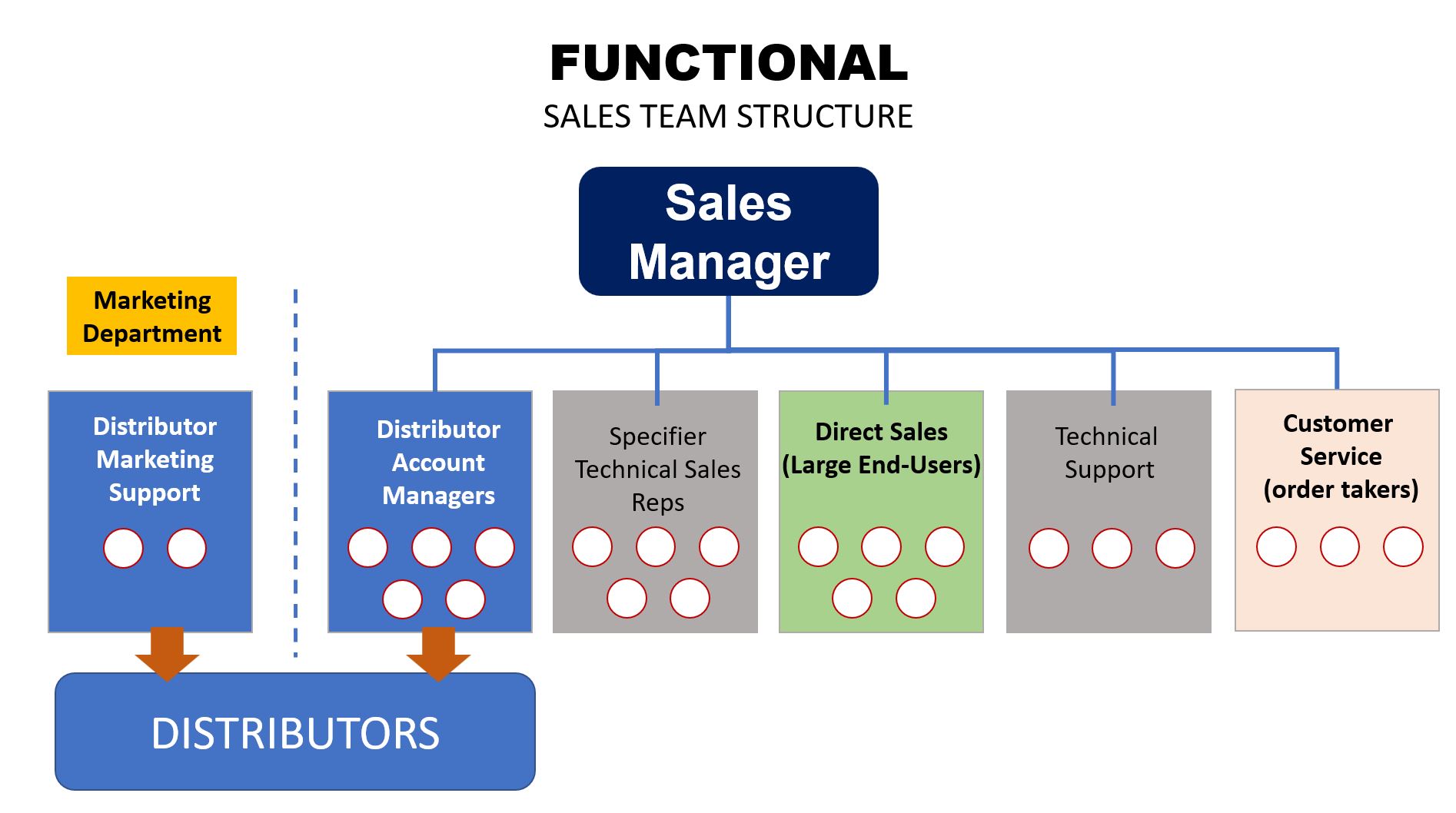
This is a typical sales department structure used by manufacturers or importers of technical products (for example: electrical, electronic, hydraulic, pneumatic, mechanical, or automation components). These types of products require a high degree of education, training, and technical support. These are specialist functions that need to be provided by the sales department.
Typically a split distribution model is employed. Smaller sales opportunities are serviced by technical product distributors that can more efficiently service small end-users, and larger customers (typically large manufacturers and mining companies) are serviced direct. $500k to $1 million sales per annum is the typical average delineation between a distributor's customer and a direct customer.
The sales department structure is organized in to specialist functions...
Direct Sales representatives service major accounts either allocated on a customer-by-customer basis or working as a team. Their primary role is to prepare quotes for major projects but often they work to encourage major customers to switch to their brand offering bundled technical support, holding customer allocated critical spares, and pricing based on large volumes.
Distributor Account Managers services the distributor network encouraging them to increase the volume of sales by arranging technical training, co-promotion, and ensuring they have adequate stocking of the most popular components. The distributor account managers also seek to expand the distribution network. Distributors are also supported by the marketing department that provides a specialist to fulfill requests for promotional material (brochures, point-of-sale), advertising material, images and tech data for the distributors' websites and social media promotion, and trade show support (display materials) to make it as easy as possible for distributors to market the products.
Technical product manufacturers/importers also provide technical specialists to provide advice on how-to-use the products and provide design services for consulting engineers and system integrators looking to design the components in to larger systems.
Specification selling is undertaken by another team who target system engineers (typically working for consulting engineering firms or system integrators) to educate them on their product range to increase the likelihood that their products will be specified in future system designs. To support specification selling the marketing department publishes (usually through the company website) extensive technical data on all products in the range, promotional and technical training videos, and CAD files that can be downloaded to make it easier for designers to incorporate the products in to design files.
Finally, a specialist customer service team is employed to take routine sales orders (from both distributors and direct customers) and to provide basic technical advice (or handing off to the technical support team if needed).
Advantages:
- Suited to sellers of technical components servicing solution providers
- Services both large customers and distribution channels
- Efficient at servicing the full range of customer types (small to large)
Disadvantages:
- Potential channel conflict with medium sized customers (direct reps stepping on the toes of distributors)
Typical industry applications:
- Manufacturers or importers of technical products
- Electrical, electronic, hydraulic, pneumatic, mechanical, or automation components
4. Ghost Rider sales structure
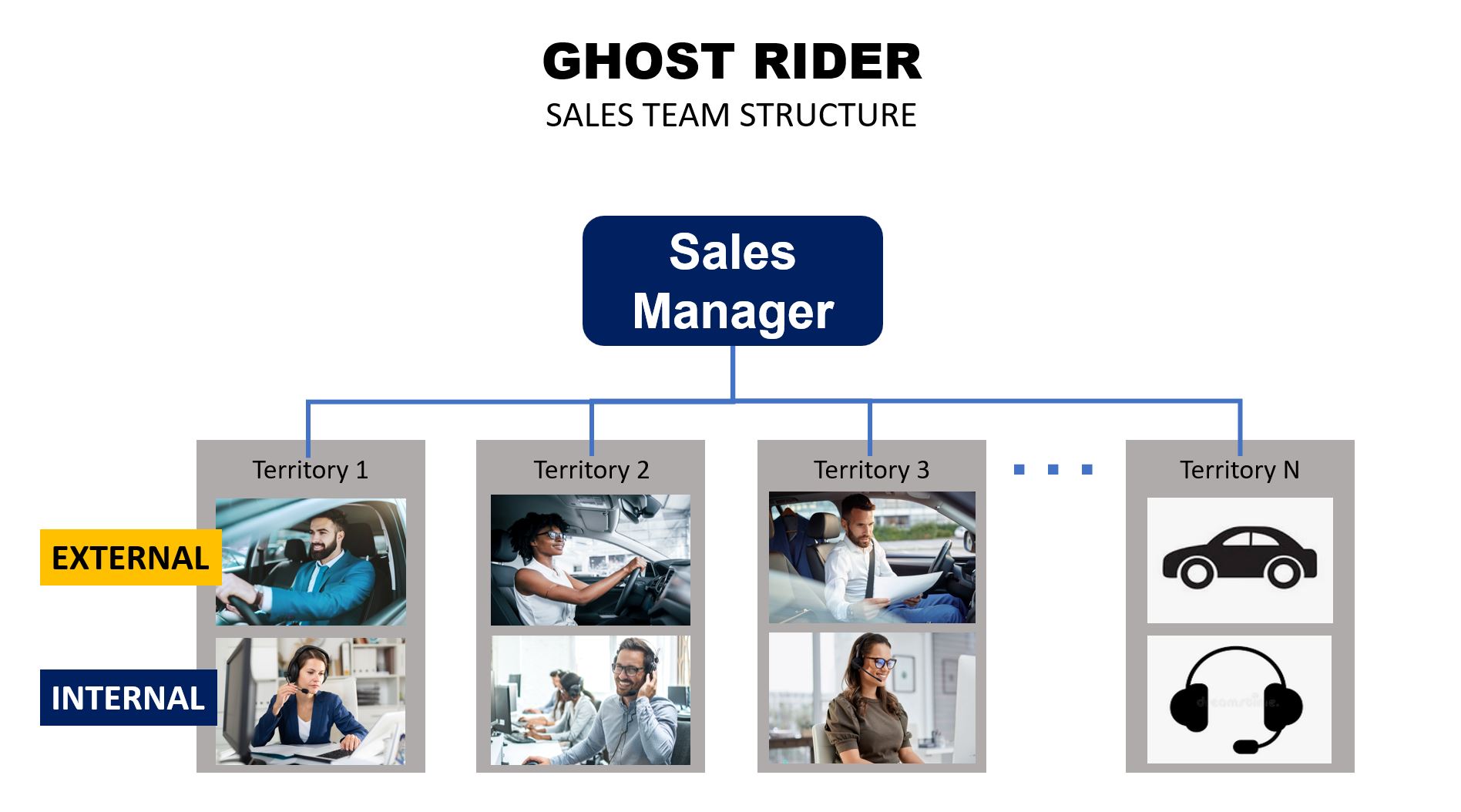
The purpose of the ghost rider sales team structure is to maximize face-to-face selling time.
External sales representatives (field sales) are paired with a dedicated internal sales person (or ghost rider).
The external sales person is in the car most of the time conducting sales meetings with customers. While driving between appointments they call their internal sales support person and brief them on the outcomes of the meeting and task them with follow-up actions. The internal sales person also briefs their external partner with the latest communications with customers and advises them on any changes to appointments.
Between talking with their external sales partner, the inside rep completes assigned tasks: provides requested customer information, prepares sales quotations, follows-up sales quotations, processes sales orders, takes inbound sales enquiries from customers in their assigned territory, conducts outbound calls to check on customers who may not have ordered for a while, and undertakes prospecting calls (looking for new customers).
Advantages:
- Maximizes face-to-face selling time.
- It's easier to employ a skilled field sales person separately to a skilled administrator. Finding these skills in one person is rare.
- Provides greater sales territory coverage per sales department headcount (working as a team 2 people can cover more territory than if both were on the road doing their own follow-up work).
- Fast follow-up of customer requests. It's very impressive when 30 minutes after seeing their sales rep they receive an email with the information they requested or a sales quotation.
- Sales representatives who are good in front of customers (and enjoy doing it) are difficult to find. The ghost rider sales team structure maximizes their value by creating more customer facing time.
Disadvantages:
- Not suited to strategic or solution selling.
Typical industry applications:
- Ideally suited to industries that are selling to majority smaller customers unlikely to span multiple territories or where decision making is on an office-by-office basis.
- Building products and services, small machinery, office equipment and office supplies, printing and sign writing, financial services (insurance, banking, non-bank commercial lending). Cleaning services. Paints, chemicals, and other consumables. Real estate. Media sales (advertising space).
5. Pipeline sales structure
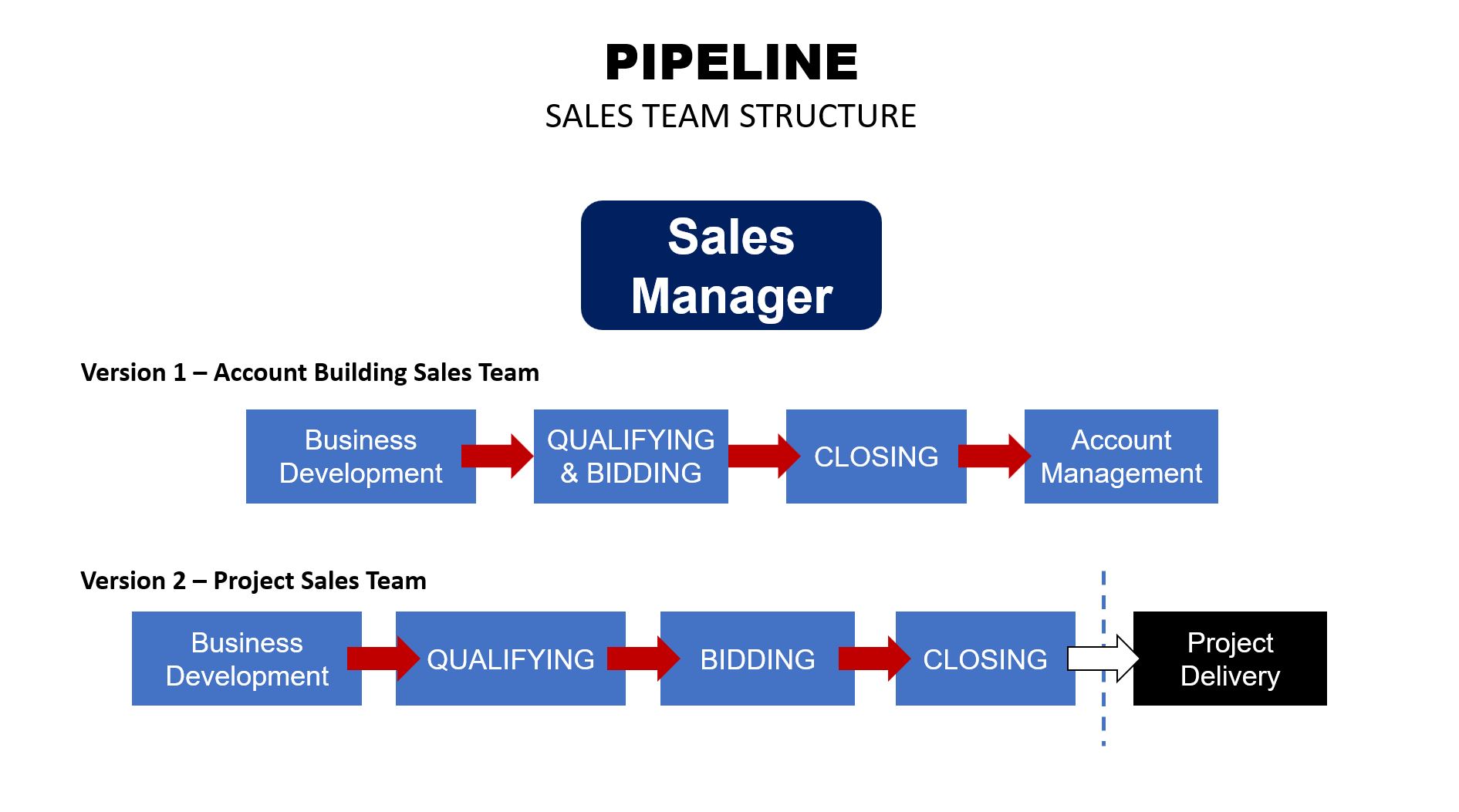
The pipeline sales department structure assigns specialist sales people to various stages in the sales pipeline. The method is to perform specific sales functions aimed at progressing sales leads from one distinct stage in the pipeline to the next until a sale is achieved.
As with all of the sales models described here, the above schematic depicts the broad concept. Each business must customize the pipeline stages and the structuring of team members (the number of stages in the pipeline and the criteria for each stage) to suit their selling model.
In the schematic the various team members and their purpose are as follows...
Business development: specialists who trawl the market place seeking potential sales opportunities. They typically use secondary research (internet and news media) and extensive business networks to identify suitable targets, then develop relationships with senior people in the target organization. The BDM may arrange for executives from the customer target to visit other sites to view the equipment/construction/service in action. Sometimes the trips are overseas. The BDM's objective is to introduce the sales target to the potential benefits and get them to the stage of seriously considering the investment.
Of course, this stage may be obviated if the potential customer has already entered the market looking at purchase options. However, many firms skilled in the art of business development seek to identify potential customers at the earliest stage possible to maximize developing strong business relationships, to influence the outcome, and to position themselves as the preferred supplier before competing firms become involved. Old B2B selling jungle saying "if the first you've heard about the opportunity is when they call tenders, you've already lost."
Qualifying: Once the BDM has successfully peaked the interest of the sales target the BDM introduces the second specialist who assists the sales target to further advance their desire for moving forward. The qualifying stage can take many forms depending on product and industry....
- Account switching: In version 1 (above) the Account Building Sales team, qualifying is about determining the interest of the sales target to switch suppliers. The qualifier presents the case for the sales target to switch to appoint them as their supplier. The aim is to determine if they are receptive to a pitch.
- Project development: In version 2 (above) the Project Sales Team presents the benefits of moving forward with a project and offers to assist with developing a business case. The business case is an internal study to quantify the cost benefit, risks, financing, and rough timeline for the investment. This business case is submitted to senior management/board to seek approval to call for a detailed proposal. The qualifying sales expert may even assist the sales target to write the specification for the tender document thus biasing the specification to their capabilities. The qualifying stage often involves presenting speculative designs (for example in the architectural industry).
Often the qualifier presents the case for moving forward with a negotiated contract (sole bidder) rather than calling for a competitive tender.
Bidding: The bidding team are another group of specialists who work solely on developing designs and costed proposals for real opportunities. Armed with the findings and insights of the BDM & Qualifier they are in a position to put forward a well considered proposal fine tuned to the customer's needs.
Closing: Some organizations employ specialists who are experienced in closing opportunities after the bid is submitted. This is particularly important for firms delivering large projects (high millions to billion dollar opportunities) typically defence fighting platform projects, large building construction, and engineered infrastructure. When the project values get high, customers can take extended periods to make decisions while they evaluate bids. Extensive review of bids requiring further information and protracted negotiations are common. Particularly with defence projects, extensive lobbying of influential people close to or involved in the decision making takes place. The closer is skilled at navigating both the politics and the practical aspects of the bid evaluation process. The closer is more often a team leader or champion of the closing process and calls upon a wide range of other specialists as needed. Their primary objective is to kick the deal over the line by whatever means possible.
Account Building Sales Team
Two variations in the pipeline sales organization structure are presented above. The account building sales team focuses on creating a customer base to service. Typically, the majority of the team half are devoted to account management (servicing existing customers aimed at retention and expansion of revenue) often referred to in sales as "farmers". Another trendy term is "customer success" team.
A smaller part of the team devotes their time to looking for and acquiring new customers. The so-called "hunters."
Project sales team
The second variation depicts a pipeline structured team commonly used to acquire project work. Once the deal is closed the sales team hand-off the customer to project delivery specialists outside of the sales department.
Separating selling from delivery
In both models the concept of separating selling from delivery is evident. This is a key concept in B2B sales. Sales people rarely make good project delivery people (and vice versa). Further, the sales process (looking for the next opportunity) is severely compromised when people must perform both roles leading to "peak and trough" revenue cycles.
However, it needs to be said that in B2B selling rarely are sales people purely from a sales background. Sales of any type of technical product or service requires people who understand the technology and have extensive domain knowledge often developed through having extensive careers working in project delivery before taking on a sales role. Also, during the sales process various subject matter specialists from anywhere in the organization are consulted during all stages in the pipeline. These people can come from anywhere in the firm not just the sales department.
In practice, large defence fighting platform prime contractors and infrastructure construction firms assemble bid teams to suit particular opportunities. Some bids can take years to reach an outcome. However, a core sales function is maintained to ensure that the pipeline always has multiple opportunities progressing through all stages to completed sales.
Advantages:
- Highly suited to long sales lead cycles typical of large transaction size sales
- Team members become highly skilled/experienced at each critical stage of the sales cycle (pipeline stages)
Disadvantages:
- Not suited to short sales cycles
- Finding specialists suited to each stage in the pipeline is more difficult and/or require more explicit and longer training programs
- Team members are at the top of the salary ranges. Highly competent people usually degree qualified are required in this selling environment. They don't come cheap.
Typical industry applications:
- Big ticket project sales (high million to billion dollar sales).
- Examples: Defence fighting platforms, infrastructure projects, enterprise and/or mission critical IT system or software development, aerospace projects.
6. Dynamic Teams sales organization Structure
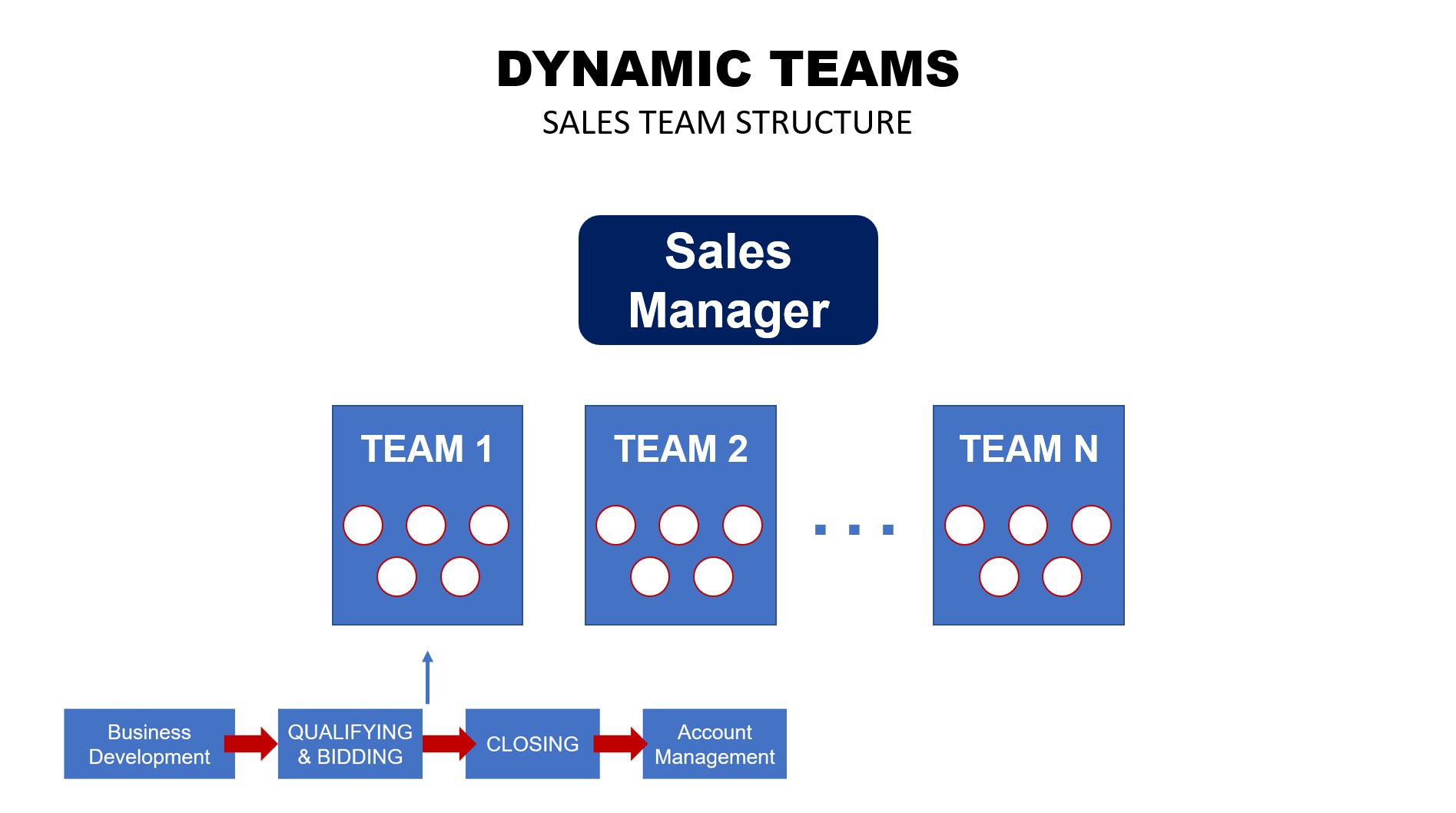
Project Sales teams:
In high revenue or complex selling environments, often sales teams are grouped into project teams to address specific sales opportunities.
These are termed "dynamic" because the composition and structure of each team is customized to the opportunity and likely will even change during the pre-sales cycle.
When chasing large projects, the project (or solution selling) firm will assemble a group of specialists to scope the opportunity at the earliest stage possible. Initially, the focus will be on capture planning (quantifying the opportunity and developing an internal business case justifying pursuing the opportunity). Bidding large projects can be hugely expensive and most firms will carefully analyze their chances of success and develop a bid strategy before committing.
If the capture plan is approved by senior management, the CEO, and (in some cases by the board), new people are added to the bid team. Once an outcome is achieved, the team is disbanded and team members are reallocated new opportunities to pursue or added to design, or project delivery roles.
Account Sales Teams:
Large firms that are set-up to service customers often break the sales department into Account Teams. Similar to the pipeline structure above, however creating multiple teams (sometimes referred to as "pods"). Each team will have mostly account managers ("farmers") and a group of specialists focused on new customer acquisition ("hunters").
Unlike the project sales teams, the account sales teams are more permanent, although from time-to-time the sales manager may move people around depending on workload and to balance teams and cross-pollinate skills.
Advantages:
- Teams are often set-up to compete to create sales department energy.
- Smaller teams create more team work (within the team)
- Same advantages as the pipeline sales organization structure but provides greater focus on a wider range of opportunities.
Disadvantages:
- Can shield individual sales reps from the raw competition they might be exposed to in single person sales teams.
- A period of low productivity is inevitable when a team is dismantled and individuals go back on the bench waiting to be assigned their next role.
Typical industry applications:
- Big ticket project sales (high million to billion dollar sales).
- Examples: Defence fighting platforms, infrastructure projects, enterprise and/or mission critical IT system or software development, aerospace projects.
7. Hook, Clean, and Fry (HCF) sales organization structure
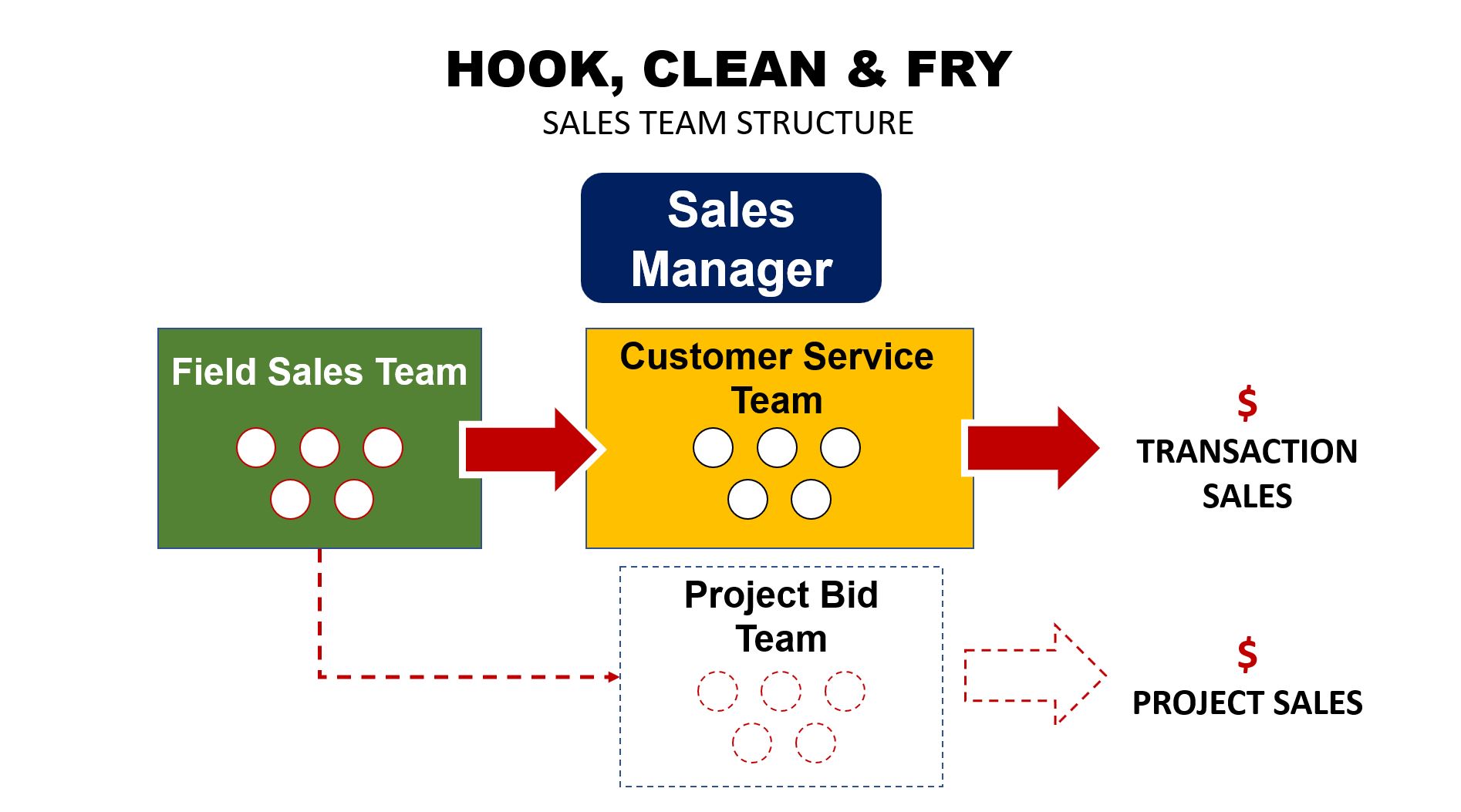
In the HCF Sales Organization Structure, the sales department is split into two main teams. A Field sales Team and a Customer Service team.
The customer service team are the order takers. They sit on the phones (call centre) and monitor emails all day and process orders received from customers. During slow periods the team perform outbound sales calls following-up lapsed customers or chasing quotes. Depending on the products being sold, the customer service team may simply be order takers, however when selling technical products and services they can also provide technical advice on product selection and usage. Further, the customer service team may also be incentivized to up-sell.
Meanwhile the field sales team are "on-the-road" maintaining contact with their major customers and promoting the products/services of the company to potential customers. The aim of the field sales team is to "grow their patch" in other words increase the number of active customers and increase the revenue per customer in their territory.
Sometimes larger customers will tender for supply contracts (commitment to an agreed volume per year of a list of products at more favorable pricing) either the field sales person negotiates this deal or it is passed to the sales manager or project team.
But here is the trick: the field sales team are not expected to take orders. Their role is to promote the customer service team with a straight forward proposition "when you need to order, don't call me - I am likely to be in a meeting - the customer service team will process your order with far greater speed and won't keep you waiting."
This is where the Hook, Clean, and Fry sales organization gets its name. The field sales team "hook" the customers and the customer service team "clean and fry' them. It's a fishing reference to when the fish are biting in such great numbers, the fishermen are reeling them in so quick they need people behind them to pick them off the deck and process them.
The HCF sales organization structure is well suited to high-volume relatively low transaction value selling. Typically, organizations employing the HCF model have a large inventory of SKUs.
Handling project sales:
In addition to transaction sales, many organizations also have project sales team that work-up detailed proposals (e.g. the sale of plant and equipment). When these opportunities are identified by either the field sales people or customer service team, they are handed over to the project bid team.
The HCF model is similar to the Ghost Rider sales organization structure described above, but without the pairing.
Advantages:
- High efficiency. Field sales people can cover far more ground (meet and influence a larger volume of customers and potential customers) as they are unencumbered by the need to work on quotes.
- High customer service. Customers don't need to wait until their rep calls them back, the customer service team are always available.
- Depending on the selling model, the customer service team are also available to respond to calls generated by inbound marketing. Such calls may be immediate sales or requests to meet with a sales representative.
Disadvantages:
- Not suited to low volume high priced transactions (typically solution selling and major projects).
- Some customers have difficulty being handed-off to a customer service team and feel the need to develop a relationship with a sales representative. This is especially true when the customer believes that their high level of repeat business warrants more personalized treatment.
Typical industry applications:
- High volume, low average unit price transaction sales
- Examples: Personal Protection Equipment, office supplies, technical components e.g. electrical or plumbing fittings, industrial consumables and Spare Parts.
----------------------------------------------
Where to from here?
Many sales organization structures are the way they are because it has never been challenged.
And there is the pain of doing so. Most of the time we are all too busy selling to ask the question "is there a better way?"
The development of strategy is the process of considering options and deciding not just what you will do, but also what you won't do. What this means is challenging the status quo; you can only know that the current sales organization structure is optimal if you compare it to alternatives.
The above seven examples of sales organization structure isn't a complete list; but, does cover the usual suspects and demonstrates the most common approaches.
The starting point for analyzing your sales organization is to first map your selling model.
The second step is to identify the distinct sales department roles and number of people required to populate the sales department. See How to develop a sales organization structure.
